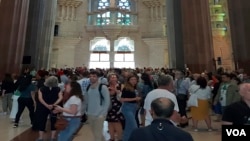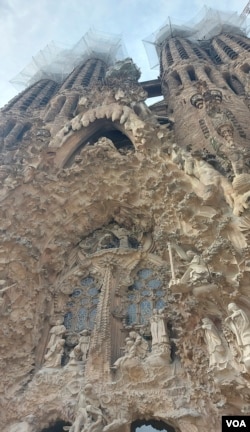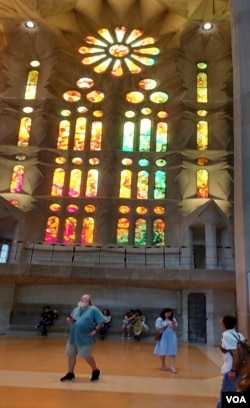Among the clutter of apartment and office blocks in Barcelona, the magnificent four towers of the Sagrada Familia stand proud like a surrealist dream.
Every day, a long line of tourists snakes around architect Antoní Gaudi’s masterpiece basilica. When they finally reach the doors, many find the wait of about an hour is worth it.
Inside is a stunning mix of Gothic, art nouveau and modernist architecture, with stained glass windows offering mosaics of yellow, pink, blue and green light.
Now the basilica, which has become a byword in Spain for anything that is unfinished, could finally be completed in 2026, marking the 100th anniversary of Gaudí’s death after he was hit by a streetcar in Barcelona at age 73. A deeply religious man, he spent much of his life designing and building the church.
But as hopes rise that the cranes could finally disappear, a specter hangs over the basilica.
The remaining architectural plans call in part for the construction of an enormous stairway leading up to the church’s unfinished main entrance — something the builders say is in line with Gaudí’s original wishes.
But this would require demolishing three blocks of flats near the temple, forcing out about 1,000 families and businesses who live and work next door.
The Junta Constructora del Temple Expiatori de la Sagrada Familia, a Roman Catholic foundation that oversees the church’s construction, is intent on proceeding with these plans, despite opposition from residents.
The final decision remains with the Barcelona City Council.
Salvador Barroso represents the Association for those Affected by the Sagrada Familia, a group suing to stop construction of the staircase.
Barroso contends that the staircase was never part of Gaudi’s plans but was added later by architects who tried to complete his vision. Much of Gaudi’s original plans were destroyed by anarchists at the outbreak of the Spanish Civil War in 1936.
“The foundation wants to go ahead with this plan for the staircase, even though it was not part of Gaudí’s original plan,” Barroso told VOA. “This is going to affect the lives of about 3,000 people who live and work next to the Sagrada. I am talking about people like me who have lived next to the building for 30 years,” he said, adding that “the fight goes on to stop this [from] happening. It is our lives, our houses, our businesses.”
Local elections in May resulted in political change on the city council. Far-left Mayor Ada Colau, who campaigned for residents’ rights before arriving at city hall, was replaced in June by the more moderate socialist Jaume Collboni.
Some people expect Collboni's administration to make decisions less favorable to neighbors of the Sagrada Familia. Colau was perceived to be firmly on their side.
Barcelona’s city council, like others in Spain, is led by the mayor. But its decisions are the result of council votes. The current administration has not indicated how or when it plans to resolve the matter.
But then nothing moves quickly with the Sagrada Familia, a building whose cornerstone was laid more than 140 years ago by a Spanish bishop.
“We are working with representatives of the Sagrada Familia, neighboring residents and other organizations to find the best solution to finish the works and the necessities of the city,” a city council spokesman told VOA, speaking under the condition of anonymity to discuss council matters.
He added that city authorities want to “guarantee the right to housing and minimize the number of people affected.”
The city council said it wants to improve facilities for people who live near the basilica and reduce the negative impact of mass tourism.
“We want to find the best solution possible to a complex situation in which there are legitimate interests, but which are evidently opposed,” the spokesman added.
The church’s four main towers have been completed and symbolize Evangelists Matthew, Mark, Luke and John. All stand 135-meters tall and have sculptures of winged creatures associated with them: an ox, an eagle, a human and a lion, the foundation said.
Architects are working on the central tower named after Jesus and are going ahead with plans for the grand staircase at the entrance.
“We are committed to complete the project of Gaudí in its entirety. For this reason, we created a forum for dialogue in February 2020 with the city council, neighbors, and other stakeholders in the city to find the best solution,” a spokeswoman for the foundation, who wished to remain anonymous, told VOA.
The dispute among the foundation, city council and neighbors is only the latest in a series of controversies that have plagued the basilica, already designated a UNESCO World Heritage Site.
In 2018, the Sagrada Familia agreed to pay city authorities $41 million over 10 years to settle a dispute after city authorities accused the builders of not having a proper building permit — a claim the builders rejected. Proceeds of the ruling were to be used to pay for transport improvements around the complex.
About 3.7 million tourists from around the world visited the basilica in 2022.






